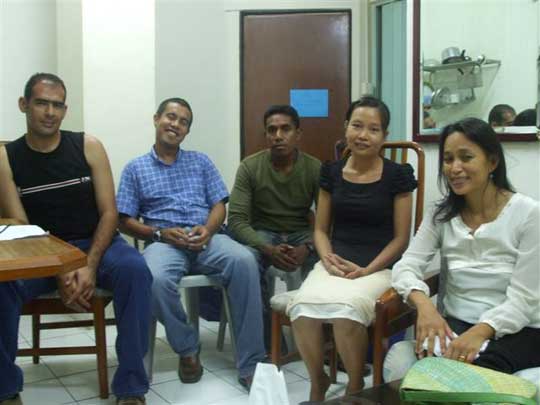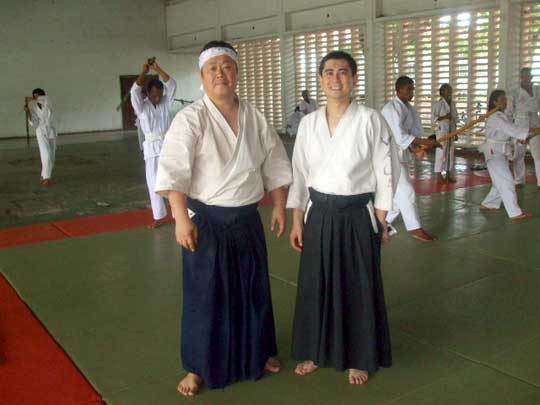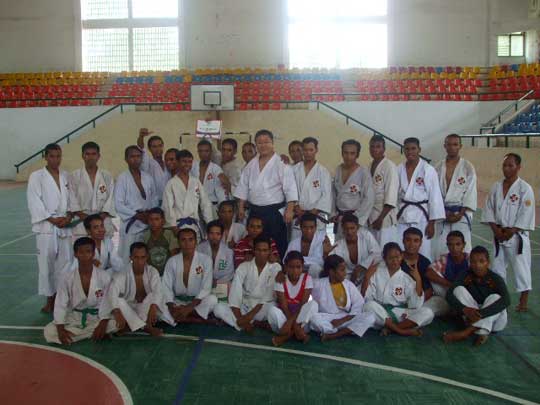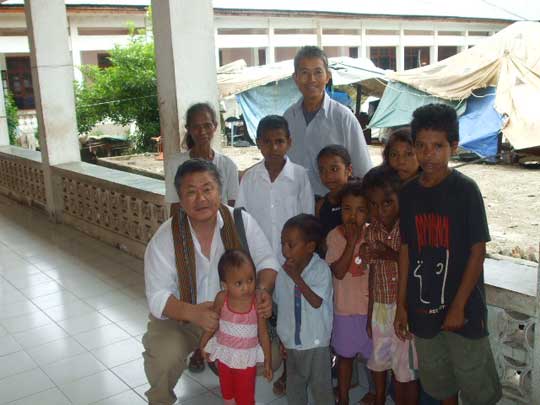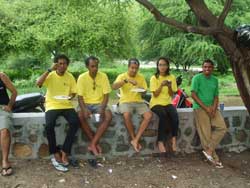East Timor
Feb 5th-11th, 2008
Feb 5th, 2008
Flew from Denpasar, Bali, Indonesia to Dili the capital of East Timor on Malpachi Airlines. The airplane cabin temperature was freezing. Why do they need to keep it so cold? The gentleman seated next to me explained that there was a very good reason– sothe flies and mosquitoes could not survive. Another passenger said it was just because the plane was old and the thermostat didn’t work any more. All of us agreed that at least the engine seemed to be working so we would all be OK. Immigration and customs at the Dili airport were similar to other developing nations I have visited. All of the officials in uniform seemed to enjoy the power of their positions and liked to show off. Mongolia I reflected was worse however…
Picking me up from the airport were UN Police instructor Ziad Ysuf Abuamer, Jacqueline Siapno (Joy) (the wife of leading Parliament dignitary, Fernando Lasama, (EDITORS NOTE; On February 11th, 2008 the President of East Timor was shot and wounded. Mr. Fernando Lasama was named as acting President of East Timor during the interim of President Horta’s recovery and is referred to unchronologically as Acting President in this article ), Mary, a women’s rights NGO activist, East Timor Aikido Federation President Francisco, and Federation Secretary Janio Aldroaldo. After checking into the hotel we held a meeting to review the schedule for the coming days ahead. With contributions from so many officials, the schedule was quite full and required a little consolidation. I always work to maintain a politically neutral position so scheduling of events can be critical. I can only teach Aikido to everyone if I maintain neutrality.. I f I attend too many official government functions, it labels me and I am then defined by my associations. It is critically important especially in a country like East Timor that is politically volatile. During the meeting Mary was brought to tears as she explained about the current conditions in her country.
We held practice in the evening. There was a wide variety of students numbering about 30. We had everyone from the Vice Prime Minister of Economy, to a revolutionary activist fresh out of jail, to a woman working to escape a violent domestic situation. Everyone seemed to have their own very personal reasons for coming. The dojo was small and did not have electricity. As soon as the sun went down we were violently attacked by mosquitoes. As soon as the mosquitoes began to arrive en masse, I got out my spray and prepared for battle. Mosquitoes seem to like me, but the feeling is not mutual.
We had dinner at the East Timor JICA (Japan International Cooperation Agency) Office presided over by Mr. Yoshikazu Wada who was one of the first Aikido pioneers in East Timor and has been teaching Aikido here for the last four years. I met Mr. Wada on my first visit to East Timor at the invitation of Sung-Ju Hwan who has since finished his tour of duty and returned to Korea. Sung Ju Hwan as well was instrumental in the development of Aikido and left large footprints during his stay in East Timor.
February 6th, 2008
Even in the early morning hours it was already very hot outside. Just stepping outside caused my t-shirt tostick to my skin. I like to visit local markets and shops on all of my travels to get a real sense of a country and its people. I especially wanted to see how the local young people spent their days and check out the graffiti, so we spent the morning touring the markets and side streets of Dili. In the afternoon we had a meeting with the East Timor Olympic Committee President Mr. Carrascalao. In East Timor, over 60 % of the population is between 25-35 years old, and we discussed the importance of sports for the development of young people.
The most valuable time of this trip was spent having lunch with local martial art instructors. In a buffet-style Indonesian restaurant, 13 leaders of different martial art groups who gathered for the occasion. There were leaders from Shorinji Kempo Karate who have 14 dojos and 600 students, Shotokan Karate who have 30 dojos and 3,030 students, Taekwondo leaders who have 50 dojos and 5,000 students. In all, six different martial arts were represented by the 13 attending instructors.
I gave each instructor an AHAN Martial Arts for Peace t-shirt I designed especially for East Timor Instructors. Much was discussed at this lunch and it was agreed that they would organize an annual joint martial art demonstration featuring all of the different martial arts in a unified manner. Sung Ju hwan set the precedent for this unifying demonstration by organizing the first-ever joint demonstration in East Timor in the fall of 2007. My hope is that this meeting will help motivate all instructors to keep this tradition alive. One Shorinji Kempo Karate instructor commented that he made his living teaching martial arts, but that teaching alone was a difficult way to make a living. His comment however was heartening as he said “By the time my grandchildren are grown, I will be very happy if they understand my efforts now.” I could understand his dedication and dream that future generations would benefit from his current efforts and sacrifices.
- Lunch with martial art instructors and leaders of East Timor.
- With Shorinji Kempo students and instructors.
- Party at the residence of Acting President Lasama.
- With Fernando Araho Lasama Acting President of East Timor.
- Memorial for the victims of political violence.
- Table set with a beautiful array of traditional foods.
Walked this morning around Dili collecting information for my articles. It was still very hot at 6:00 pm. when evening practice was held. Students in Dili do not have bokken and jo, so last night I asked if we could make bokken and jo’s out of bamboo. Tonight they brought the finished bokken and jo to class so we were able to practice with weapons. The bamboo in this area has a very small hole in the center so the bokken and jo’s were strong and, even if a little heavy for beginners, perfect for weapons practice. They did a very good job making the practice weapons and I was pleased we were able to practice the Nippon Kan Bokken and Jo kata.
February 8th, 2008
In the morning we visited the Fokpers NGO which is a women’s support organization against domestic violence, crimes against women and working for women’s protection rights. While I understand and support the focus of their organization, I found that their point of view was extremely anti-male. They wanted me to teach Aikido to the women victims in their organization, but I decided that my philosophy of the Aikido practice did not yet blend with their intentions. The way I practice and teach Aikido is a way of working together with people, working towards blending with harmony, not using Aikido against any group defined by race, culture or gender. In the current situation in East Timor, women’s emerging rights are important, but I did not want to teach techniques to this group to be used for fighting. I hope that someday this situation will evolve to include Aikido as a way to work towards more harmonious interaction between the men and women in East Timor.
In the afternoon, we went to visit the Catholic Monastery to visit Father Horie. Father Horie has served as a Catholic missionary for many decades, having served in the Amazon for 15 years before being sent to East Timor where he has taught and administered to the poor for the last seven years. Refugees from the 2006 civil war still live in a tent city built on the monastery grounds. Father Horie works diligently to care for these refugees as well as his students and staff. The staff cut their own food allowance to the bare minimum in order to feed the refugees in their care. On the day I visited, the staff’s dinner consisted of a bowl of rice with a think soup broth and one finger-sized banana. Nippon Kan AHAN General Headquarters made its second donation of powdered milk as part of our own small efforts to help the refugees.
Later in the afternoon I walked around Dili once again to study the gang graffiti so prevalent in this city.
- Visit with Father Horie
- Simple dinner for six for the monastery staff.
A three-hour practice today beginning at 8:00 am. We covered a variety of taijutsu techniques followed by weapons practice with the student’s new jos. We had lunch at a Brazilian restaurant with a UN economic advisor, the Japanese Embassy staff and member of the infrastructure rebuilding engineer corp. Many topics were discussed concerning the current developments in the rebuilding of East Timor’s infrastructure and social systems. Due to the international presence in East Timor there is a wide variety of international restaurants in Dili where foreigners from around the world can find their native cuisine.. All were expensive, however, and not frequented by the local population.
- Markets are well organized.
- Sorry for the goat.
- Better not to get too close!
- New Year Chinese lion dancers.
February 10th, 2008
We held practice in the morning. While we practiced, a group of about 20 to 30 people gathered outside. After practice, I returned to my hotel to change out of my keiko gi, and when I returned there were about 300 people gathered in the same spot. They all wore keiko gi and wore colored belts marked with crosses. When they bowed, they made the sign of the cross in front of their foreheads. Everyone was barefoot. I was to learn that this was a CORKA, martial art group that was originally founded in 1993 in Indonesia. This group was well organized and seemingly disciplined. Unfortunately they did not demonstrate any of their techniques while I watched them, and I was not sure of the intention of this gathering, but their presence was solemn and massive. I learned that there are other Indonesian based Bujutsu groups in East Timor, one other being Silat Kamvung and groups called “55” and “77.” It was reported that many of these groups incorporate shamanistic values of prayer in their training. I was lucky and was able to talk for a few moments with one of the CORKA leaders.
- CORKA Bujutsu martial art group gather in the streets.
- With one of the CORKA leaders.
Wear AHAN martial arts for peace t-shirts at a picnic. front and back!
February 11th, 2008
When I awoke that morning, I could tell that something was wrong. In the sky, Australian military helicopters hovered slow and deliberately, low on the horizon. UN police vehicles and military cars moved in quickly through the streets.
I had a meeting scheduled this morning with Mr. Hornay, the Principal of the Police Academy. At the meeting, I was told what was going on. East Timor’s President Halta (the second president since East Timor gained its independence as a nation in 2002) had been attacked at his palace and shot. The Prime Minister was also shot in a second attack while in transit from his home. Luckily, neither shot had proved fatal. I was already scheduled to leave East Timor that day, and I was lucky that my flight was scheduled to depart before a complete state of emergency was declared and travel prohibited.
This was not the first time I have been in a situation like this. In 2005 I was lucky to get out of Kathmandu, Nepal during a political coup and government take-over. Comparing the two, this situation in East Timor seems a little calmer, yet concerning all the same as anti-government elements attempted to assassinate the president.
- With Jorne Police academy principal Mr Hornay.
- Front of radio station dispatched Austrialian soldiers.
I was lucky and my plane departed East Timor just before a national state of emergency was declared and all transportation was grounded. I left Dili and East Timor behind and after a short flight landed once again in Denpasar, Bali, Indoneisa where I spent an evening walking in the crowded streets filled with rich tourists from China, Singapore, Taiwan and Japan. Only a two-hour flight from East Timor to Bali, but the realities of life in these two countries could not have been further apart.


